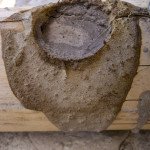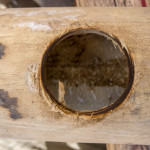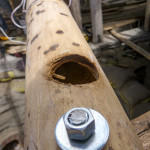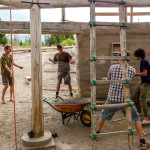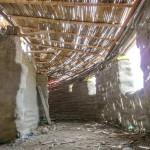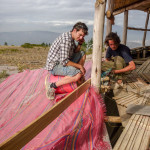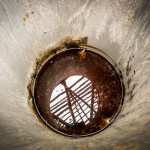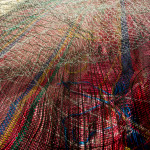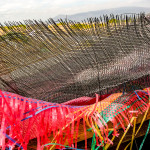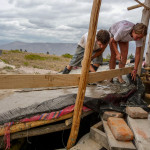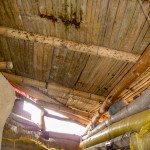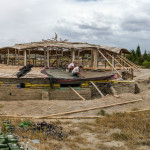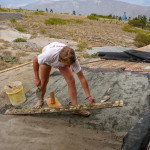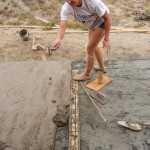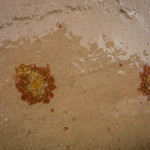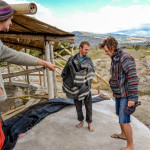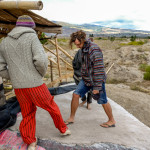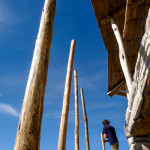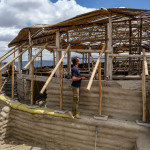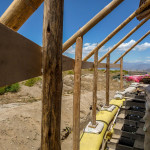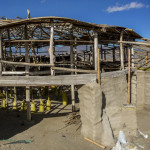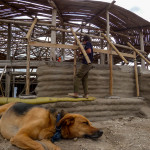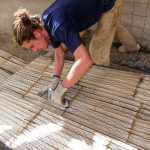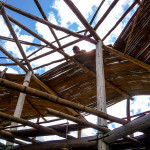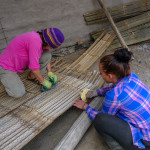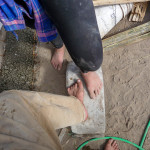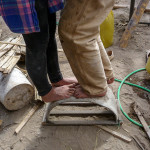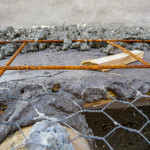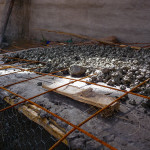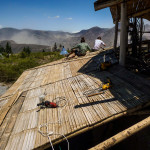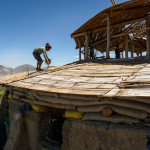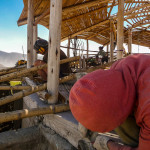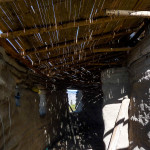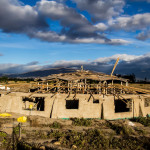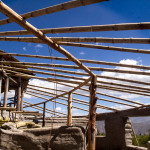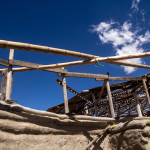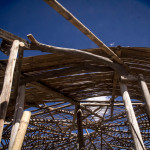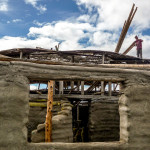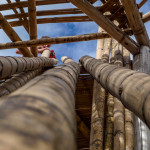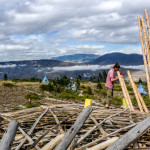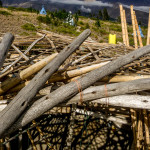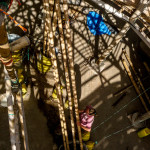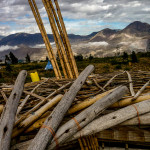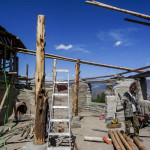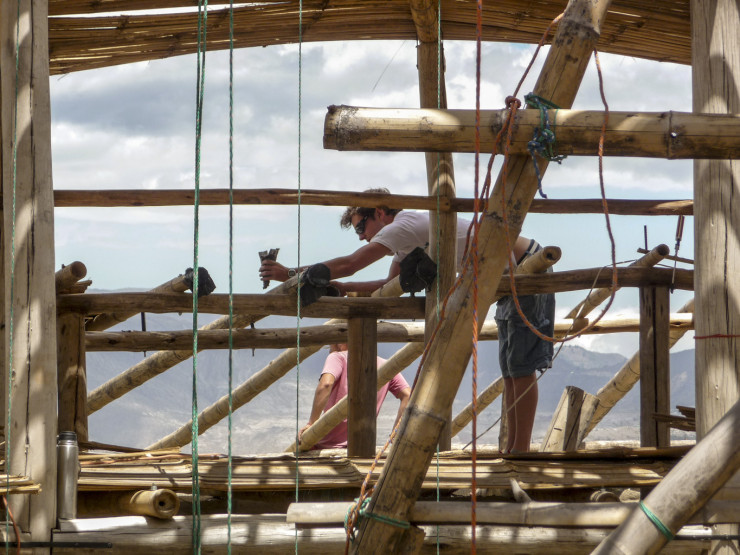
Bamboo usually breaks around the connection points, because the hole weakens the structure and being hollow it can just bend in half like a straw. To solve this problem we used a technique developed by Colombian Architect, Simón Vélez. It involves first bolting the bamboo, then drilling a hole next to the bolt and filling the entire node with concrete. We used a fairly watery mix to help it fill quicker, and vibrated the bamboo by tapping it to help it fill the space.

Before bringing in the cement mixer we decided to mix some concrete by hand to practice the process. We put the ferrocement on the smallest part of the roof. First we painted on a concrete milk, the idea was to completely encapsulate the nylon shade cloth in the bottom 1mm of concrete. This meant that we couldn’t put on the nylon or chicken wire until the mixing had begun, which would have made the whole process quite rushed on the day the mixer came. We decided that the concrete would likely seep through the gaps in the nylon anyway so the milk wasn’t necessary. This meant that we could prepare the nylon and chicken wire before mixing the concrete, so that pouring would be much easier.
We cured the concrete for three days by keeping it wet, and then jumped on it! This is the smallest roof section so its not a true test, but so far so good.
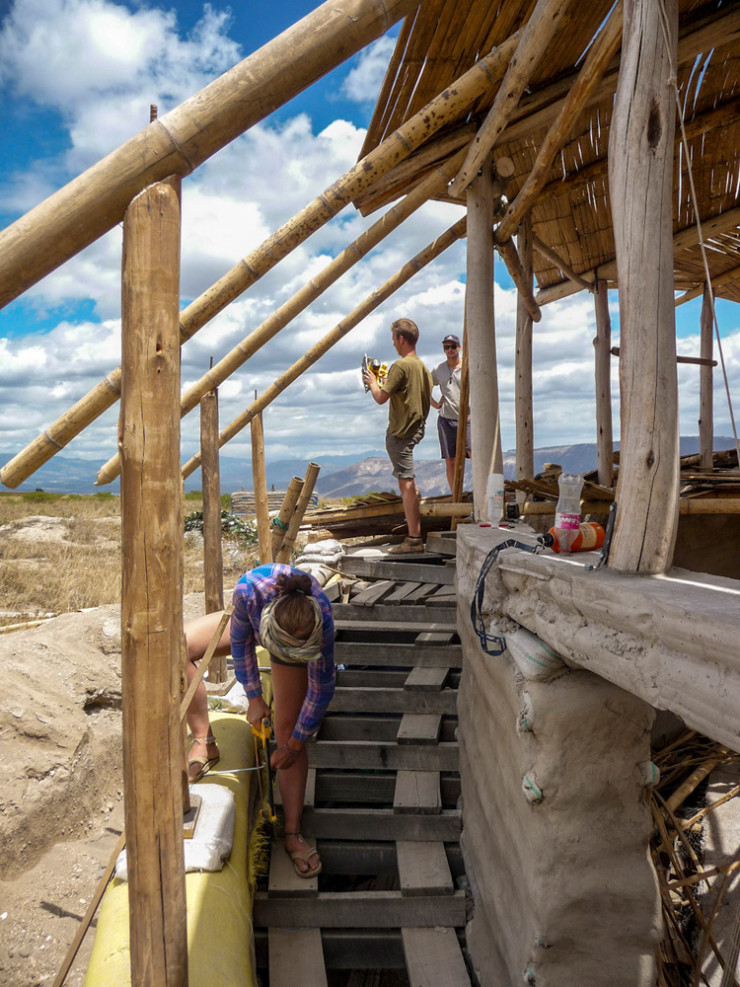
More columns and beams were added to make a cover for the staircase. The wall of this space will be covered with glass (or polycarbonate) to let in light from the large entrance to the staircase, the east facing doorway. The space can then also be used for plants.
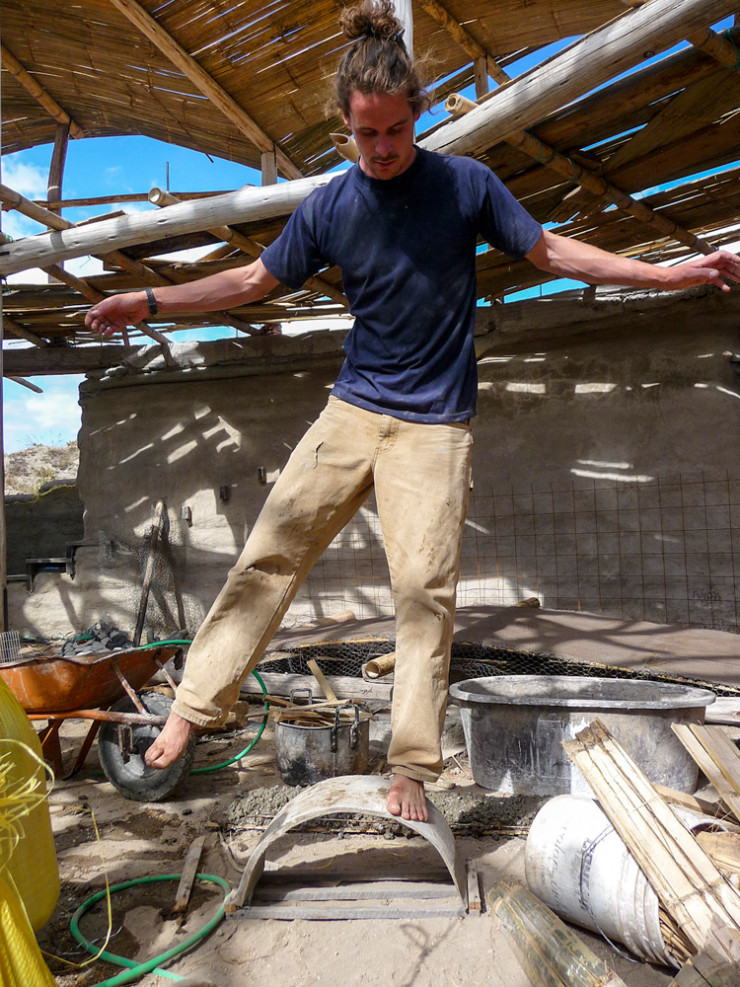
We’re going to use ferrocement for the roof. The original plan, (for the past 18 months) was to try Latex Cement. This was pioneered by George Nez, it’s modified reinforced concrete, and its only 1cm thick. In their examples the they use a hyper parabolic shape which takes much of the force to the beams, but its still extremely strong. They use 2 layers of fibreglass mesh (flyscreen gridded mesh not fibreglass matt) for reinforcement and 1cm of latex modified cement. When the book was published it was recommended to use a styrene-butadine additive, the same stuff they make car tyres with (and chewing gum). But recent studies by William Seth Carleton (2013) show that a powder based Acrylic additive is superior in terms of strength, UV resistance and toxicity, whilst being far easier to work with. Well, we could only find the styrene-butadine additive in Ecuador, and it was going to cost around $2000. So we started looking for alternatives. We tested a few types of latex whilst researching the options, the arch in the photo is made using two layers of fibreglass mesh, PVA modified cement and sawdust as an aggregate. PVA isnt recommended as its water soluble even after drying, and the saw dust probably isnt a good idea either. That said it was strong! It held my weight even when I wasn’t standing on the top of the arch. It held two of us for about 5 seconds before breaking.
Ferrocement is a technique first developed for boat building, a strong rebar form is covered with multiple layers of chickenwire and around 3cm of cement. Its very strong. Our form will be permanent, cladding of split bamboo, which is incredibly strong in tensile strength. For this reason we decided not to use thick rebar in the recipe.
Our structure consists of:
- Bamboo beams
- Split bamboo cladding
- Reused polypropylene bags to stop the mix falling through the gaps in the bamboo)
- Nylon shade cloth – reinforcement in the bottom mm of cement, prevents hairline cracks (see meshcrete)
- Chicken wire
- 2-3cm cement – 3:1 sand:cement
- 0.5 cememt polish coat – 2:1 fine sand:cement
For any of the more structural elements, like the shallow arches on the hall roof, we will also add a layer of PumiceCrete. This is a technique we learnt from Steve Kornher’s website, its more or less the same recipe as above but with an additional layer of driveway mesh (10cmx10cm spaced welded rebar mesh) and 10cm of pumicecrete. The pumicecrete is simply pumice (presoaked in water) and portland cement to a ratio of 8:1. No sand necessary. A final polish coat is then applied to waterproof. When pouring fresh concrete on top of old, he recommends wetting the old and painting on a cement milk to glue the two layers together. This is just cement and water to a creamy consistency.
- Luke & Feli’s Photo
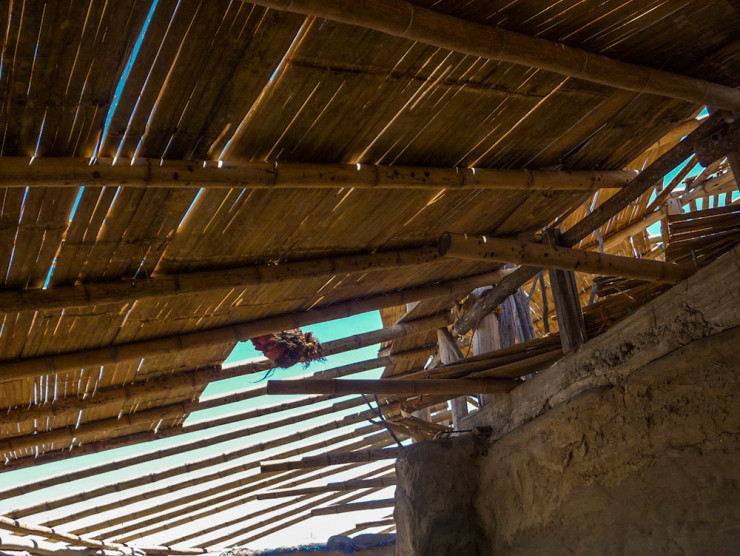
We started nailing the split bamboo onto the beams. We should have hired a nail gun.
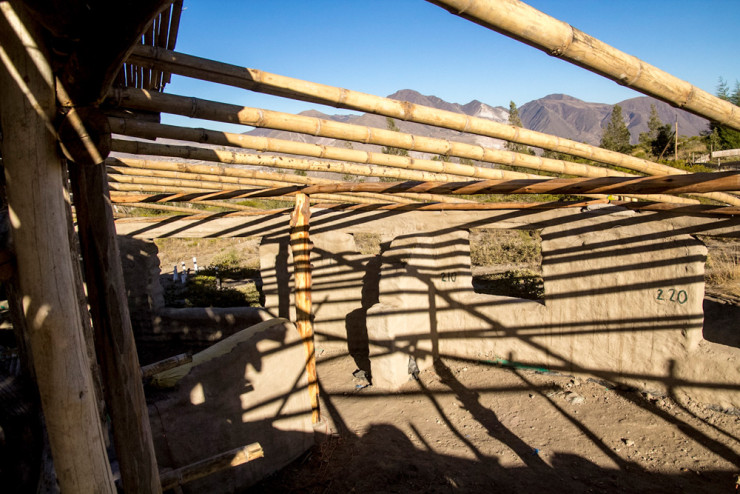
Things are starting to take shape now that the bamboo beams are in place. They are first bolted to the 3 parallel beams, then the space around the bolt is filled with concrete to strengthen the connection. More to come on this in a later post.
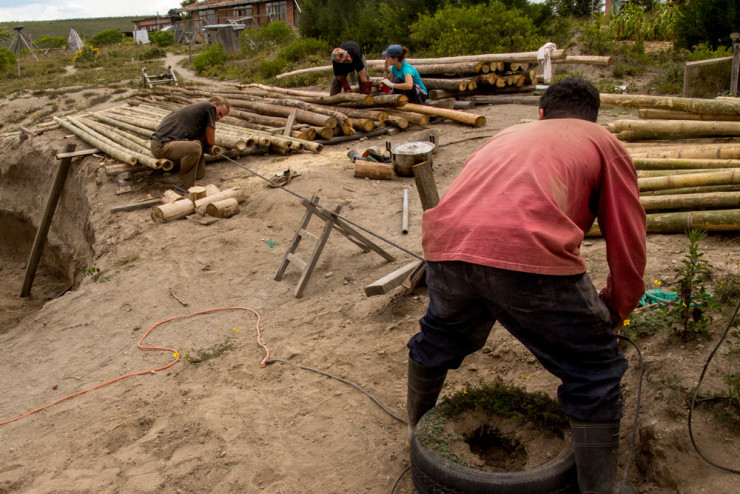
We treated all the bamboo poles with borax. We first drilled a hole through the centre of the poles using a 6m long drill bit, yes, 6m. We got our welder in town to weld a 1/2” drill bit onto a 6m long piece of rebar, he thought we were crazy but it worked surprisingly well. Then we raised the bamboo vertically and poured in borax solution whilst rotating the pole. We later decided to drill two holes because the borax was taking so long to drip through, it was so easy drilling the holes that it saved a lot of time. With the 9 meter poles that are sticking out of the roof in the pictures we had to drill from both sides, it took a while.
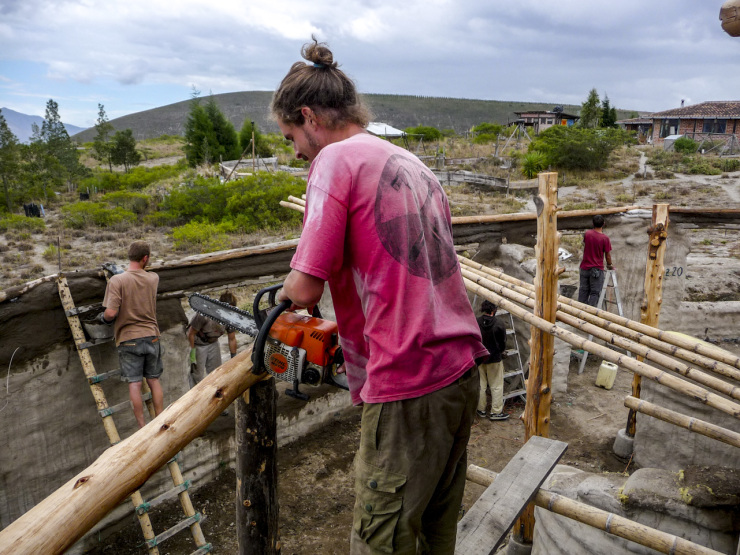
In the centres of each room is now a column, the next job was to make a beam across the tops of these columns, the middle parallel beam, well, the middle spiralling beam.
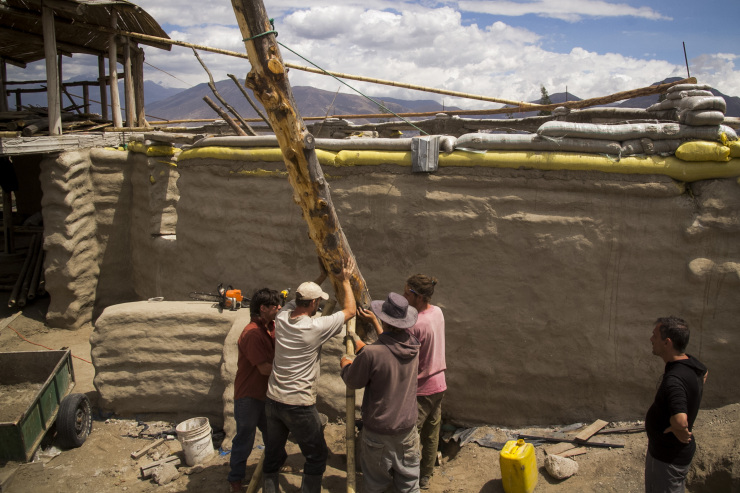
The spiraling outer roof is held up by 3 parallel beams, 1 on top of the outer wall, one attached to the columns above the concrete bond beam, and one in-between (where the span is over 4m). This ‘in-between beam’ will be held up by a line (well, spiral) of cypress columns. We rescued these columns from the side of the road in the local town.
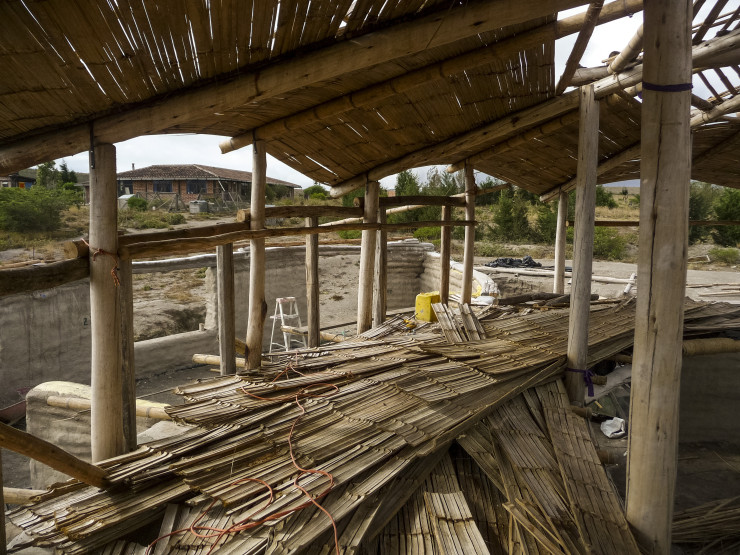
The top beam is bolted to the 24 columns above the bond beam. We didn’t want the weight of the roof to rest on the bolts alone so we added some additional columns to each beam, taking the weight directly into the concrete bond beam.
© 2024 Another Bag in the Wall | Theme by Eleven Themes

